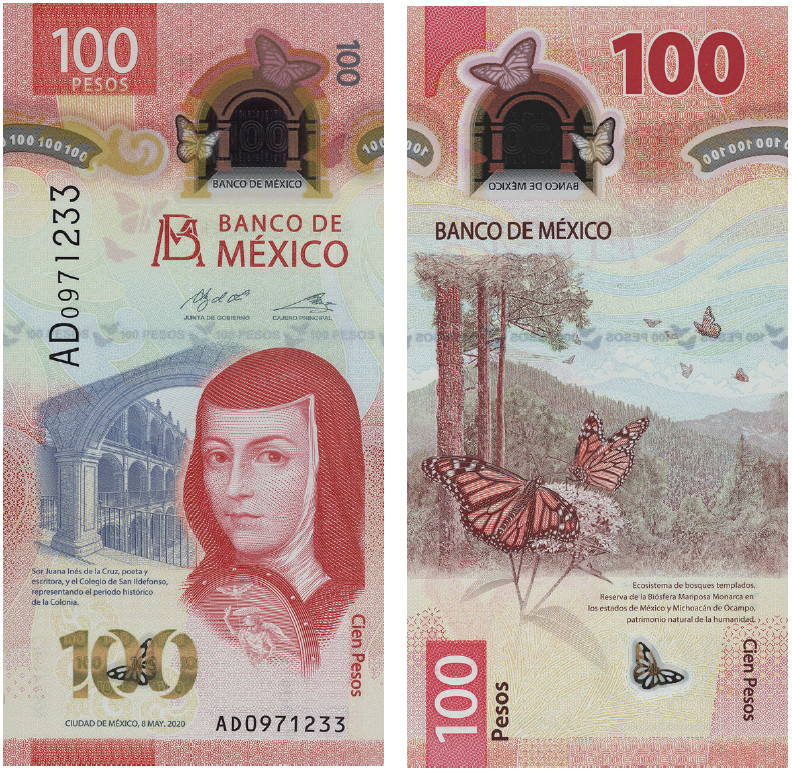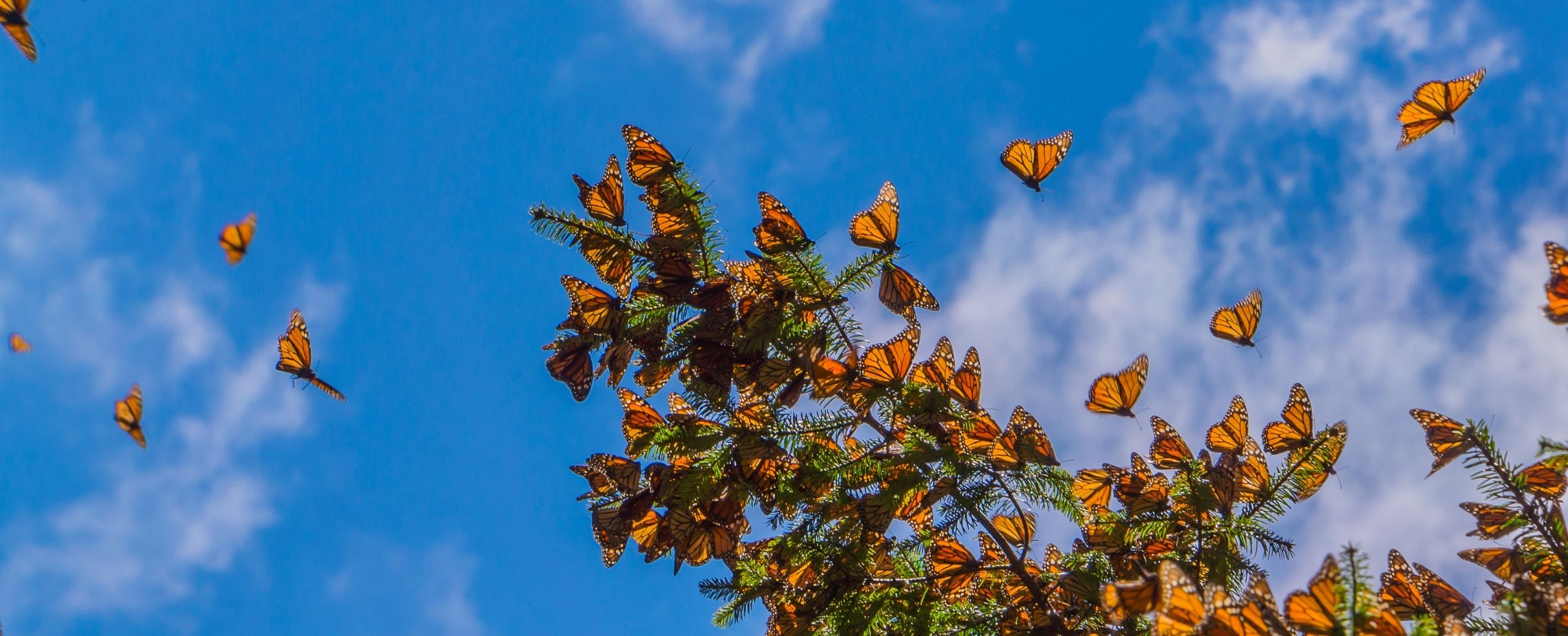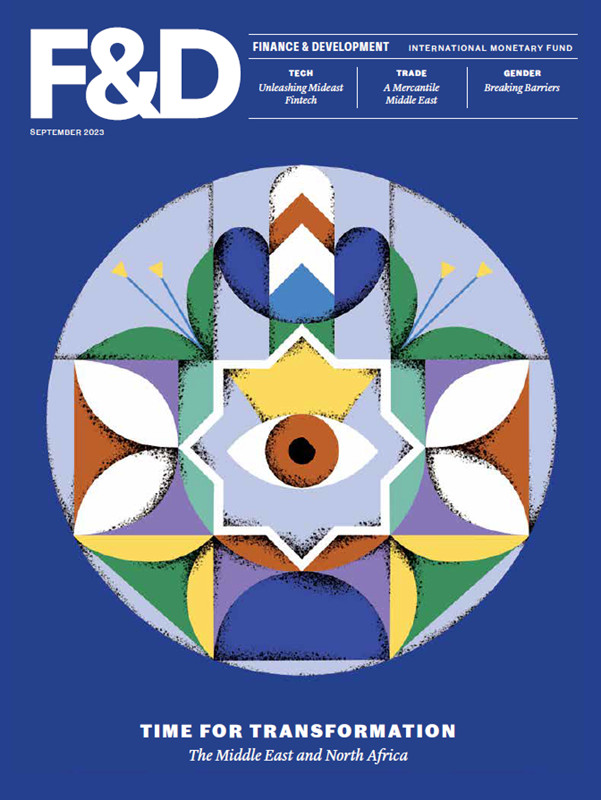Mexico’s 100-peso banknote features migratory butterflies and an influential poet
While digital currency may be capturing the headlines these days, it’s worth noting that physical currency—cold, hard cash—is also undergoing sophisticated technological advancements in many countries, often highlighting messages that help tell unique stories of their cultures or environment.
Take Mexico’s newly redesigned 100-peso banknote, for example. No stern founding fathers or stately monuments are depicted on this colorful bill. Instead, migratory butterflies, a temperate forest ecosystem, and a groundbreaking 17th century female poet.
A few years back, the Bank of Mexico had decided to reimagine the designs of its already colorful paper currency, along with its coins. The bank wanted to feature a more design-forward nod to Mexico’s cultural and natural heritage, telling more inclusive stories of the country while incorporating the latest technology.
The vibrant red and yellow, vertically oriented polymer 100-peso banknote debuted in November 2020 as part of a newly designed series, and last year was chosen “Bank Note of the Year” by the International Bank Note Society (IBNS), a first for the country. “Mexico’s award-winning entry may provide a template as other countries reconsider how they design and promote new banknotes,” according to an IBNS statement.
The 100-peso bill is Mexico’s first vertical polymer banknote, and has anti-counterfeiting and accessibility features including:
- color-shifting ink with a sliding bar movement effect and color change from gold to green;
- a clear window with embossed security features and metallic iridescent ink;
- a design revealed by fluorescent ink under ultraviolet light; and
- raised ink.

MEXICO’S 100-PESO BANKNOTES FEATURE THE 17TH CENTURY WRITER SOR JUANA INÉS DE LA CRUZ AND THE MONARCH BUTTERFLY BIOSPHERE RESERVE, A UNESCO WORLD HERITAGE SITE. (IMAGES: BANK OF MEXICO)
A literary founding mother
The front of Mexico’s 100-peso banknote pays tribute to one of Latin America’s most important early female writers, Sor Juana Inés de la Cruz (1648–1695), a prolific poet, playwright, philosopher, and nun, who wrote in Spanish, Latin, and Nahuatl. Known as a defender of enlightenment thinking and indigenous culture, Sor Juana (“Sister Juana”) is sometimes referred to as the “Founding Mother of Mexican literature” and considered “the most important poet and writer of New Spain’s literature,” according to the Bank of Mexico.
The bank’s director of currency issuance, Alejandro Alegre, says that Sor Juana is depicted as “a learned and determined woman, who fought against the conventions of her time that limited women’s access to culture and freedom of thought, in order to become the greatest figure of the Hispanic American letters of the 17th century.” She was previously featured on Mexico’s 200-peso note.
The banknote also depicts the arches of the colonial-era Antiguo Colegio de San Ildefonso in Mexico City’s historic center. The 18th century baroque building, a onetime Jesuit seminary and now a museum, was the birthplace of the country’s 20th century muralism movement. Artists including José Clemente Orozco and Diego Rivera painted some of their first murals on the building’s courtyard walls.
Mighty, mystical mariposas
Mexico’s 100-peso notes also pay tribute to a remarkable creature and one of the world’s most fascinating annual migrations. Every autumn in the forests of Michoacán and the State of Mexico, the Monarch Butterfly Biosphere Reserve—a protected UNESCO World Heritage site depicted on the back of the banknote—welcomes millions of the migratory orange-and-black monarch butterflies (mariposas monarcas), the ethereal, photogenic, and at-risk insects revered by climate scientists as a marker of climate health, and celebrated in music, poetry, and Mexican folklore as bringing good luck or even representing the souls of the dead. The Bank of Mexico’s Alegre notes that the monarch butterfly has “an important symbolism for Mexicans, as important spiritual and cultural values have been attributed to it.”
The monarchs fly thousands of miles from the northern United States and parts of Canada to hibernate in the oyamel fir trees of central Mexico, 9,000 feet above sea level. This is the largest monarch butterfly colony in the world, and their long-distance trips count as the world’s “most highly evolved [migration] of any known species of their kind,” according to the World Wildlife Federation (WWF). The monarch butterflies’ numbers are declining drastically, according to the WWF, due to climate change, deforestation, and the conversion to farmland, along with increased use of pesticides in their US breeding grounds and disappearing milkweed, the exclusive food of monarch caterpillars.
As the world pays increasing attention to climate change and biodiversity, the tiny but mighty monarch butterfly gracing Mexican banknotes is a powerful reminder of the importance of a flourishing environment. As Cambridge economist Sir Partha Dasgupta put it in a recent Finance & Development article, “A thriving natural environment, underpinned by abundant biodiversity, is our ultimate safety net.” In other words, what is good for the butterflies is good for us all.
Opinions expressed in articles and other materials are those of the authors; they do not necessarily reflect IMF policy.









